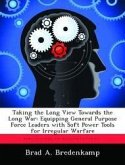The top priority for the United States Air Force (USAF) is fighting and winning the Global War on Terror (GWOT). Indirect action is the primary solution, but direct, kinetic actions are called for in the short term. The USAF is evolving to meet GWOT challenges, but it is still using airpower not optimized or cost effective in counterinsurgency (COIN) operations, and it is providing the vast majority of strike for all GWOT partners. These two areas are where a dedicated, manned COIN aircraft like the Raytheon AT-6 can make a significant impact. The USAF is engaged in COIN today in Iraq and Afghanistan using legacy platforms at significant cost. Yet the density of coverage with these assets is not sufficient to cover everywhere they need to be, reducing our capability to win in the eyes of insurgents and terrorists. To achieve dense, persistent coverage requires large numbers of aircraft and using aircraft such as F-15Es and F-16s is simply not cost effective for the results obtained. The continuous use of high-end conventional platforms when they are not required is an unnecessary drain on resources. The AC-130 and strike-capable UAVs are similarly limited by cost for the benefits received when compared to an aircraft like the AT-6. Conventional fighters and UAVs are not ideal for Foreign Internal Defense (FID) either. Cost and sustainability issues plague them both. There are also operational limitations and cultural acceptance issues that are problems in terms of FID.







